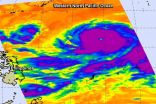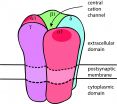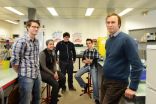INFORMATION:
Study: Even motivated dieters need close access to healthy food
UMMS and DPH findings challenge previous conclusions about healthy eating and neighborhood environment
2014-10-07
(Press-News.org) You're obese, at risk for diabetes and cardiovascular disease, and so motivated to improve your diet that you've enrolled in an intensive behavioral program. But if you need to travel more than a short distance to a store that offers a good selection of healthy food, your success may be limited.
A new study from UMass Medical School and the Massachusetts Department of Public Health finds that not having close access to healthy foods can deter even the most motivated dieters from improving their diet, suggesting that easy access to healthy food is as important as personal motivation and professional guidance from health care providers.
"Community health programs should be evidence based, but many studies have showed conflicting associations between the distance to grocery stores and lower or higher prevalence of obesity and diabetes," said principal investigator Wenjun Li, PhD, associate professor of medicine and director of the Health Statistics and Geography Lab in the Division of Preventive and Behavioral Medicine at UMMS and senior author of the study.
"Our study is different. It looks at whether neighborhood environment becomes a limiting factor when a person wants to improve their diet. If you live far away from a grocery store, and you are trying to change your diet, will that affect you or not? To our knowledge, this is the first study to look at that," said Dr. Li.
Published online by the American Journal of Preventive Medicine October 6, "Access to Healthy Food Stores Modifies Effect of a Dietary Intervention" was conducted in Worcester County with 240 obese adults with metabolic syndrome who participated in a randomized clinical trial comparing two dietary interventions, the American Heart Association Dietary Guidelines or an exclusive focus on increasing fiber intake.
"They were referred by their physicians to make lifestyle changes, including dietary changes. They are highly motivated," said Li. "Even if they live far away from [our clinic], they travel long distances to learn how to change their lifestyles."
But even among these motivated individuals, those who travelled a shorter distance from home to the nearest food store with adequate healthy food choices, defined as at least one item in each of 20 categories, achieved greater gains in dietary fiber consumption and total fruit and vegetable servings.
Data from these patients, who participated in the intensive 14-session behavioral weight management program at UMass Memorial Medical Center, was correlated with extensive data on the availability of healthy food in their communities. Li noted that the multifaceted study design led to accurate, reliable results based on both high-quality individual nutritional data and community environment data.
"The strong informatics support from the UMMS Information Technology Department made it possible for us to cost-effectively process community food environment data," Li noted. "The results reflect a fresh look at the environmental impact on healthy eating by a multidisciplinary team comprising statisticians, a geographer, nutrition scientists, a psychologist, a cardiologist and a public health officer."
The effect of living closer to a healthy food store remained constant regardless of other factors including age, race, education and income. Eighty-nine percent of participants were white; almost half had at least a bachelor's degree; one-third reported household income exceeding $75,000 a year; and almost all owned cars.
But with almost 40 percent of stores in the study area not meeting criteria for healthy choices, "The striking finding is that in order for a dietary intervention to be effective, the participant needs a supportive neighborhood environment," said Li.
Understanding the relationship between supportive neighborhood environments and individual efforts to combat obesity can inform community health improvement efforts including the DPH's Mass in Motion initiative, as well as other federal, state and private programs.
"The findings of this study support a cornerstone theory of the Mass in Motion program that supportive environments can facilitate behavior change and ultimately improve health," said co-author Thomas Land, PhD, director of the Department of Public Health's Office of Data Management and Outcomes Assessment. "DPH is committed to Mass in Motion and the promise of improved community health that it delivers."
With this and further investigations, Li and DPH partners hope to provide the evidence that is lacking to shift public policy in order to provide coordinated, multifaceted interventions for obesity that take into account the community environment as well as the individual.
For example, communities with limited access to healthy food stores could provide public land and tax incentives to attract business owners.
"Changing the environment alone cannot produce results. However, efforts to try to change a person will be very limited without improving the environment," Li concluded. "This is why both aspects should be pursued at the same time with coordinated efforts."
ELSE PRESS RELEASES FROM THIS DATE:
Around the world in 400,000 years: The journey of the red fox
2014-10-07
Imagine attempting to trace your genetic history using only information from your mother's side. That's what scientists studying the evolution of the red fox had been doing for decades.
Now, University of California, Davis, researchers have for the first time investigated ancestry across the red fox genome, including the Y chromosome, or paternal line. The data, compiled for over 1,000 individuals from all over the world, expose some surprises about the origins, journey and evolution of the red fox, the world's most widely distributed land carnivore.
"The genome and ...
NASA eyes Super typhoon Vongfong
2014-10-07
Typhoon Vongfong strengthened into a Super typhoon on Tuesday, October 7 as NASA's Aqua satellite passed overhead.
On Oct. 7 at 0429 UTC (12:29 a.m. EDT) the Atmospheric Infrared Sounder called AIRS that flies aboard NASA's Aqua satellite captured cloud top temperature data on Super typhoon Vongfong. AIRS data very strong thunderstorms circling Vongfong's clear 27 nautical-mile wide eye. Those cloud top temperatures were colder than -62F/-53C indicating that they were high in the troposphere and capable of generating heavy rainfall. The bands of thunderstorms circling ...
Very low concentrations of heavy metals and antibiotics contribute to resistance
2014-10-07
New Swedish research shows that plasmids containing genes that confer resistance to antibiotics can be enriched by very low concentrations of antibiotics and heavy metals. These results strengthen the suspicion that the antibiotic residues and heavy metals (such as arsenic, silver and copper) that are spread in the environment are contributing to the problems of resistance. These findings have now been published in the highly regarded journal mBio.
Antibiotic resistance is a growing medical problem that threatens human health worldwide. Why and how these resistant bacteria ...
Efficacy of potential therapy for autoimmune disorder of muscle weakness
2014-10-07
PHILADELPHIA — Nearly 60,000 Americans suffer from myasthenia gravis (MG), a non-inherited autoimmune form of muscle weakness. The disease has no cure, and the primary treatments are nonspecific immunosuppressants and inhibitors of the enzyme cholinesterase.
Now, a pair of researchers from the Perelman School of Medicine at the University of Pennsylvania have developed a fast-acting "vaccine" that can reverse the course of the disease in rats, and, they hope, in humans. Jon Lindstrom, PhD, a Trustee Professor in the department of Neuroscience led the study, published ...
Advocating weight diversity
2014-10-07
A new review of the way health care professionals emphasise weight to define health and wellbeing suggests the approach could be harmful to patients.
Author of the review article, Dr Rachel Calogero of the School of Psychology at the University of Kent, together with experts from other institutions and organisations, recommends that this approach, known as 'weight-normative', is replaced by health care professionals, public health officials and policy-makers with a 'weight-inclusive' approach.
Weight-inclusive approaches, such as the Health At Every Size initiative, ...
Hospitalized patients don't wash their hands enough, study finds
2014-10-07
Hamilton, ON (October 7, 2014) – Hospital visitors and staff are greeted with hand sanitizer dispensers in the lobby, by the elevators and outside rooms as reminders to wash their hands to stop infections, but just how clean are patients' hands?
A study led by McMaster University researcher Dr. Jocelyn Srigley has found that hospitalized patients wash their hands infrequently. They wash about 30 per cent of the time while in the washroom, 40 per cent during meal times, and only three per cent of the time when using the kitchens on their units. Hand hygiene rates ...
Probiotic yogurt could help protect against heavy metal poisoning
2014-10-07
LONDON, ON – New research shows probiotic yogurt can reduce the uptake of certain heavy metals and environmental toxins by up to 78% in pregnant women. Led by Scientists at Lawson Health Research Institute's Canadian Centre for Human Microbiome and Probiotic Research, this study provides the first clinical evidence that a probiotic yogurt can be used to reduce the deadly health risks associated with mercury and arsenic.
Environmental toxins like mercury and arsenic are commonly found in drinking water and food products, especially fish. These contaminants are particularly ...
The 'cyberwar' against cancer gets a boost from intelligent nanocarriers
2014-10-07
Two years ago, Prof. Eshel Ben-Jacob of Tel Aviv University's School of Physics and Astronomy and Rice University's Center for Theoretical Biological Physics made the startling discovery that cancer, like an enemy hacker in cyberspace, targets the body's communication network to inflict widespread damage on the entire system. Cancer, he found, possessed special traits for cooperative behavior and used intricate communication to distribute tasks, share resources, and make decisions.
In research published in the Early Edition of the Proceedings of the National Academy of ...
Satellite sees Tropical Storm Simon over Baja California
2014-10-07
NOAA's GOES-West satellite took a picture of Tropical Storm Simon weakening over Mexico's Baja California.
On Oct. 7, a Tropical Storm Watch was in effect for Punta Abreojos to Punta Eugenia, Mexico. The National Hurricane Center expects Simon to produce storm total rainfall amounts of 3 to 5 inches with isolated amounts around 8 inches through Wednesday, Oct. 8, across northern portions of the Baja California Peninsula and the state of Sonora in northwestern Mexico. Over the next few days, storm total rainfall amounts of 1 to 2 inches with isolated amounts of around ...
Anorexia/bulimia: A bacterial protein implicated
2014-10-07
Eating disorders (ED) such as anorexia nervosa, bulimia, and binge eating disorder affect approximately 5-10% of the general population, but the biological mechanisms involved are unknown. Researchers at Inserm Unit 1073, "Nutrition, inflammation and dysfunction of the gut-brain axis" (Inserm/University of Rouen) have demonstrated the involvement of a protein produced by some intestinal bacteria that may be the source of these disorders. Antibodies produced by the body against this protein also react with the main satiety hormone, which is similar in structure. According ...
LAST 30 PRESS RELEASES:
Gut health à la CAR T
Dr. Pengfei Liu receives 2026 O'Donnell Award in Medicine for pioneering advances in genetic diagnostics and rare disease treatment
Dr. Yunsun Nam receives 2026 O'Donnell Award in Biological Sciences for pioneering RNA research transforming gene regulation and cancer therapy
Dr. Bilal Akin wins 2026 O'Donnell Award in Engineering for transformative work in EV energy systems and industrial automation
Dr. Fan Zhang receives 2026 O'Donnell Award in Physical Sciences for groundbreaking discoveries in quantum matter and topological physics
Dr. Yue Hu receives 2026 O'Donnell Award for revolutionizing energy operations with real-time AI and reinforcement learning
Greater risk that the political right falls for conspiracy theories
JMC Publication: Insilico’s AI platforms enable discovery of potent, selective, oral DGKα inhibitor to overcome checkpoint resistance
Targeting collagen signaling boosts drug delivery in pancreatic cancer
Valvular heart disease is common in cancer patients but interventions improve survival
When socially responsible investing backfires
Cuffless blood pressure technologies in wearable devices show promise to transform care
AI-based tool predicts future cardiovascular events in patients with angina
Researchers map how the cerebellum builds its connections with the rest of the brain during early development
Routine scans could detect early prostate radiotherapy changes
Fairness in AI: Study shows central role of human decision-making
Pandemic ‘beneath the surface’ has been quietly wiping out sea urchins around the world
Tea linked to stronger bones in older women, while coffee may pose risks
School feeding programs lead to modest but meaningful results
Researchers develop AI Tool to identify undiagnosed Alzheimer's cases while reducing disparities
Seaweed based carbon catalyst offers metal free solution for removing antibiotics from water
Simple organic additive supercharges UV treatment of “forever chemical” PFOA
£13m NHS bill for ‘mismanagement’ of menstrual bleeds
The Lancet Psychiatry: Slow tapering plus therapy most effective strategy for stopping antidepressants, finds major meta-analysis
Body image issues in adolescence linked to depression in adulthood
Child sexual exploitation and abuse online surges amid rapid tech change; new tool for preventing abuse unveiled for path forward
Dragon-slaying saints performed green-fingered medieval miracles, new study reveals
New research identifies shared genetic factors between addiction and educational attainment
Epilepsy can lead to earlier deaths in people with intellectual disabilities, study shows
Global study suggests the underlying problems of ECT patients are often ignored
[Press-News.org] Study: Even motivated dieters need close access to healthy foodUMMS and DPH findings challenge previous conclusions about healthy eating and neighborhood environment




